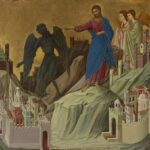Duccio di Buoninsegna (c.1255-c.1319)
Guarigione del cieco nato (The Healing of the Man born Blind)
c.1307–1311
Egg tempera on wood, 45.1 × 46.7 cm
National Gallery, London
This painting comes from the back of the predella of the large, double-sided altarpiece made for Siena Cathedral, known as the Maestà.
Jesus, in a vivid blue robe edged with a fine gold line, places his finger over the eyelids of a man who clings to a stick made from a simple tree branch. The stick shows that he is blind – he uses it to guide his steps. This episode in Jesus’s ministry is told in the Gospel of John. Jesus and his disciples came across a blind beggar. He made a paste from earth and is shown here wiping it across the man’s eyelids. Jesus then told him to go and wash in the pool of Siloam; after doing this, he was, according to witnesses, able to see again. At the right edge of the panel Duccio shows the man again, by the pool. He has laid down his stick, which he no longer needs.
The figure of Jesus stooped over the man divides the scene into two. Behind him are his disciples, huddled together. The elder disciples, perhaps Peter and Paul, are at the front of the crowd. Only the tops of the heads of those behind are visible, emphasising how dense the crowd is and giving the image a sense of depth.
The detailed architectural structures of the background – with open doors and windows, archways and semi-enclosed courts – also add depth and complexity to the scene. The turreted towers and beamed ceilings reflect the architecture of a medieval city like Siena, rather than Roman-occupied Jerusalem where the event was believed to have taken place centuries earlier. Duccio has set one of Christ’s greatest miracles in the home town of the people who would have seen the painting, bringing it to life for them.
The pool of Siloam is represented as a small street fountain; green water gushes from the mouth of a sculpted lion’s head. This detail is found in other, earlier, Italian versions of the picture and also in a Byzantine manuscript; it is possible this image was drawn from a Byzantine manuscript. These versions also show the man twice, usually being healed and then washing his eyes in the pool. Here, the man instead looks up and raises his hand in amazement or reverence. The scene next to this one on the predella was The Transfiguration – when Jesus was filled with divine light. The blind man in this scene would have looked up towards the the transfigured Christ, acknowledging the source of his healing but also recalling Jesus’s words to his disciples as he healed the man: ‘While I am in the world, I am the light of the world’ (John 9: 5).
Infrared reflectography, which reveals the drawing beneath the paint, shows that two artists worked on this scene. Duccio himself probably drew the figures and sketched in the architecture but it seems to have been drawn more precisely by a different artist – one of Duccio’s assistants. If you look closely, you’ll see fine indentations along the edges of the buildings and their features. These were made with a sharp pointed tool and a ruler to ensure their straightness and accuracy. Part of the blind man’s face, including both eyes and nose, has been restored. (NG)
Virtual reconstruction of the Maestà Altarpiece (1308-1311).
Virtual reconstruction of the Maestà Altarpiece (back).
Central panel:
 Duccio di Buoninsegna (c.1255-c.1319)
Duccio di Buoninsegna (c.1255-c.1319)
Maestà
1308–1311
Duomo di Siena, Siena
Predella:
 Duccio di Buoninsegna (c.1255-c.1319)
Duccio di Buoninsegna (c.1255-c.1319)
Annunciazione
c.1307–1311
National Gallery, London
 Duccio di Buoninsegna (c.1255-c.1319)
Duccio di Buoninsegna (c.1255-c.1319)
Cristo e la Samaritana
1310–1311
Museo Thyssen-Bornemisza, Madrid
 Duccio di Buoninsegna (c.1255-c.1319)
Duccio di Buoninsegna (c.1255-c.1319)
La vocazione degli apostoli Pietro e Andrea
1308–1311
National Gallery of Art, Washington
 Duccio di Buoninsegna (c.1255-c.1319)
Duccio di Buoninsegna (c.1255-c.1319)
Natività con i profeti Isaia ed Ezechiele
1308–1311
National Gallery of Art, Washington
 Duccio di Buoninsegna (c.1255-c.1319)
Duccio di Buoninsegna (c.1255-c.1319)
Resurrezione di Lazzaro
1310–1311
Kimbell Art Museum, Fort Worth
 Duccio di Buoninsegna (c.1255-c.1319)
Duccio di Buoninsegna (c.1255-c.1319)
Tentazione sul monte
1308–1311
Frick Collection, New York
 Duccio di Buoninsegna (c.1255-c.1319)
Duccio di Buoninsegna (c.1255-c.1319)
Trasfigurazione
c.1307–1311
National Gallery, London


